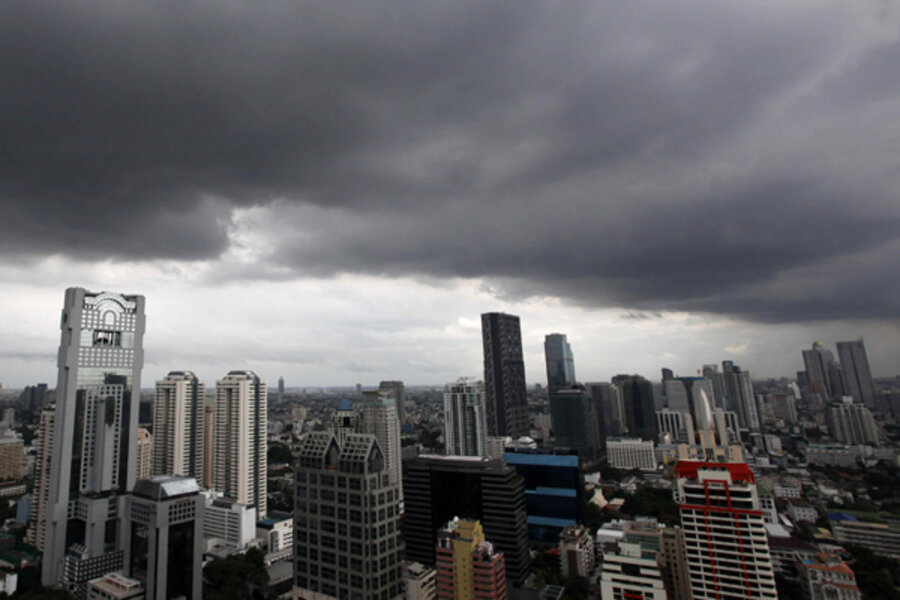Could city farming be a solution for Bangkok’s urban poor?
Loading...
| Bangkok, Thailand
At first glance there’s nothing remarkable about the Laksi District Office building on the outskirts of Bangkok. The concrete building is like any other government office in the city, on a busy road surrounded by skyscrapers and a car park. But hiding behind its white brick walls on the seventh floor is a luscious rooftop farm, housing more than a hundred varieties of vegetables that could help the country’s urban poor.
The garden was set up in 2003 by a group of janitors who decided to use empty space on the building’s roof to grow food to take home to their families. In the 10 years since, it has blossomed into a fully functioning urban horticulture center, complete with trellises crisscrossed with vines and rows of potted herbs and spices. It covers an area roughly 4,000 square meters (about 4,300 sq. feet), that otherwise would be an expanse of unused concrete.
The guerrilla garden is one of several small city farms dotted around Bangkok. And now, a group of nutritional experts say the trend could be harnessed to improve access to food for Thailand’s growing numbers of urban poor.
“Historically, community gardens have served many functions in Europe. Bangkok could benefit in the same way,” says Robert Holmer, a German agriculture expert who is regional director of the World Vegetable Center.
Dr. Holmer was one of several authors of a new study carried out by Bangkok’s Kasetsart University and the University of Freiburg in Germany, which set out to assess Bangkok’s suitability for producing more fresh produce inside the city limits. In the year 2000, Bangkok’s population was 6.3 million, roughly 10 percent of the total population of Thailand. Today it’s ballooned to more than 9 million in the capital, 15 million with the surrounding suburbs.
Thailand’s capital has just 3 sq. meters of green space per resident – one of the lowest ratios in Asia. Despite the lack of open space, researchers found a surprising number of low-income families growing vegetables, herbs, and spices unofficially in parks, in building lots, and on windowsills around the city.
“If this could be regularized and encouraged with the backing of the Thai government, then the potential for feeding the city’s growing numbers of residents could be big,” says Holmer. He says the trend could be built on to encourage even more families to produce fresh produce to supplement their diets.
Though food shortages are relatively rare in Bangkok, rising food prices have hit poor communities here hard. According to the Food and Agriculture Organization, the diets of low-income families in the capital have seen a significant deterioration in the past few years, with families increasingly consuming cheap, highly processed foods with low nutritional content.
“When times are hard, fruit and vegetables are the first to go and people opt for energy-dense food that is nutritionally lacking,” says Holmer. “Obesity is on the rise in Bangkok even among the urban poor.”
When Bangkok was hit with massive flooding in 2011, for example, food supplies to the city were completely cut off, leaving families even more vulnerable than before.
In the 10 years the Laksi rooftop farm has been operating it has proved so successful, the janitors not only feed themselves, they sell the produce in local markets. The gardeners also started training members in the community in vegetable production to encourage more urban farm plots. To date, more than a 1,000 people have gone through the informal program.
The Kasetsart University study used Geographical Information System (GIS) technology to digitally map areas in Bangkok either already being used to grow food or with the potential to grow food in the future. They combined this with door-to-door surveys asking people where they source their fresh food.
“We found over 160 varieties of vegetables are grown and consumed in Bangkok,” says Holmer. He says most of what is grown is vegetables and spices used for Thai cooking that are not stocked in regular supermarkets.
The study also noted vacant spaces including walls, roofs, parks, and industrial lots that could be utilized to grow fresh food and even rice and grains.
Food experts in Asia, where cities are growing at a faster rate than anywhere else, have long been searching for innovative ways to improve food supplies. And incorporating informal home produce networks in cities will improve poor people’s resilience, said Food and Agriculture Organization assistant director general Hiroyuki Konuma at a recent conference in Bangkok.
They are now working with the Thai government to introduce an allotment law that would mean communities could officially apply to the local authorities to turn disused or vacant plots into city gardens.
However, critics say despite the potential benefits urban farming brings to urban poor, planners need to be realistic about how viable an option is given the value of real estate in a city like Bangkok.
“It doesn’t make economic sense to use a small plot of land in the middle of a city to grow food on when that plot can be sold as real estate for a far higher value,” says Daniel Hoornweg, professor and Jeff Boyce research chair at the University of Ontario Institute of Technology. Until 2012 he was an urban development strategist at the World Bank.
It’s also difficult for governments to rely on hobby farmers in urban areas for a regular food supply. Instead, says Professor Hoornweg, urban agriculture is most beneficial when it is integrated into other city plans. Including using it as a way to increase green space – which benefits residents while keeping real estate values high.
“There are some who see [urban agriculture] as a solution to everything and others who think it is a joke,” says Hoornweg. “We need to find a middle ground.”







